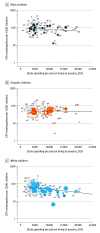Public Benefit Programs and Differential Associations With Child Maltreatment by Race and Ethnicity
- PMID: 38109092
- PMCID: PMC10728799
- DOI: 10.1001/jamapediatrics.2023.5521
Public Benefit Programs and Differential Associations With Child Maltreatment by Race and Ethnicity
Abstract
Importance: Public benefit programs, including state spending on local, state, and federal-state partnership programs, have consistently been associated with overall reductions in child protective services (CPS) involvement. Inequities in eligibility and access to benefit programs may contribute to varying associations by race and ethnicity.
Objective: To determine whether associations between state spending on benefit programs and rates of CPS investigations differ by race and ethnicity.
Design, setting, and participants: This cross-sectional ecological study used repeated state-level measures of child maltreatment from the National Child Abuse and Neglect Data System and population estimates from the US Census Bureau for all Black, Hispanic, and White children. All 50 US states from October 1, 2009, through September 30, 2019 (fiscal years 2010-2019), were included. Data were collected and analyzed from May 13, 2022, to March 2, 2023.
Exposures: Annual state spending on benefit programs per person living below the federal poverty limit, total and by the following subcategories: (1) cash, housing, and in-kind; (2) housing infrastructure; (3) child care assistance; (4) refundable earned income tax credit; and (5) medical assistance programs.
Main outcomes and measures: Race- and ethnicity-specific rates of CPS investigations. Generalized estimating equations, with repeated measures of states, an interaction between race and spending, and estimated incidence rate ratios (IRRs) and 95% CIs for incremental changes in spending of US $1000 per person living below the federal poverty limit were calculated after adjustment for federal spending, race- and ethnicity-specific child poverty rate, and year.
Results: A total of 493 state-year observations were included in the analysis. The association between total spending and CPS investigations differed significantly by race and ethnicity: there was an inverse association between total state spending and CPS investigations for White children (IRR, 0.94 [95% CI, 0.91-0.98]) but not for Black children (IRR, 0.98 [95% CI, 0.94-1.02]) or Hispanic children (IRR, 0.99 [95% CI, 0.95-1.03]) (P = .02 for interaction). Likewise, inverse associations were present for only White children with respect to all subcategories of state spending and differed significantly from Black and Hispanic children for all subcategories except the refundable earned income tax credit (eg, IRR for medical assistance programs for White children, 0.89 [95% CI, 0.82-0.96]; P = .005 for race and spending interaction term).
Conclusions and relevance: These results raise concerns that benefit programs may add relative advantages for White children compared with Black and Hispanic children and contribute to racial and ethnic disparities in CPS investigations. States' eligibility criteria and distribution practices should be examined to promote equitable effects on adverse child outcomes.
Conflict of interest statement
Figures


Similar articles
-
Association of State Expansion of Supplemental Nutrition Assistance Program Eligibility With Rates of Child Protective Services-Investigated Reports.JAMA Pediatr. 2023 Mar 1;177(3):294-302. doi: 10.1001/jamapediatrics.2022.5348. JAMA Pediatr. 2023. PMID: 36689239 Free PMC article.
-
Racial and ethnic disparities in fecundability: a North American preconception cohort study.Hum Reprod. 2025 Jun 1;40(6):1183-1194. doi: 10.1093/humrep/deaf067. Hum Reprod. 2025. PMID: 40246287
-
Racial and Ethnic Minorities Underrepresented in Pain Management Guidelines for Total Joint Arthroplasty: A Meta-analysis.Clin Orthop Relat Res. 2024 Sep 1;482(9):1698-1706. doi: 10.1097/CORR.0000000000003026. Epub 2024 Mar 18. Clin Orthop Relat Res. 2024. PMID: 38497759
-
Racial and Ethnic Differences in Out-of-Pocket Spending for Maternity Care.JAMA Health Forum. 2025 Feb 7;6(2):e245565. doi: 10.1001/jamahealthforum.2024.5565. JAMA Health Forum. 2025. PMID: 40019741 Free PMC article.
-
Multifaceted behavioral interventions to improve topical glaucoma therapy adherence in adults.Cochrane Database Syst Rev. 2025 Jun 11;6(6):CD015788. doi: 10.1002/14651858.CD015788.pub2. Cochrane Database Syst Rev. 2025. PMID: 40497459 Review.
Cited by
-
State Policy Levers for Reducing Early Childhood Maltreatment: The Importance of Family Planning and Economic Support Policies.Child Maltreat. 2025 Aug;30(3):565-578. doi: 10.1177/10775595241267236. Epub 2024 Sep 27. Child Maltreat. 2025. PMID: 39332909 Free PMC article.
-
Promoting Health Equity for Children With Special Health Care Needs and Child Welfare Involvement.Hosp Pediatr. 2025 Feb 1;15(2):186-193. doi: 10.1542/hpeds.2024-008075. Hosp Pediatr. 2025. PMID: 39813168
References
Publication types
MeSH terms
LinkOut - more resources
Full Text Sources
Medical

